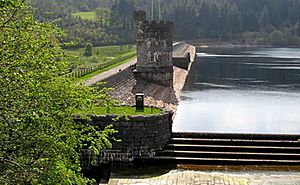Llwyn-on Reservoir facts for kids
Quick facts for kids Llwyn-on Reservoir |
|
|---|---|
 |
|
| Location | South Wales |
| Coordinates | 51°47′50″N 3°26′27″W / 51.79722°N 3.44083°W |
| Type | reservoir |
| Primary inflows | Taf Fawr, Nant Gwinau, Nant Car, Garwnant |
| Primary outflows | Taf Fawr |
| Basin countries | United Kingdom |
Llwyn-on Reservoir (also called Llwyn Onn Reservoir) is the biggest and most southerly of three reservoirs in the Taf Fawr valley in South Wales. It was built to provide more water for the city of Cardiff. The city's water company, Cardiff Corporation Waterworks, got special permission from Parliament in 1884 to build these reservoirs. However, work on Llwyn-on Reservoir didn't start until 1911 and was finished in the 1920s.
Today, Welsh Water owns and manages the reservoir. It has done so since 1973. The reservoir is located inside the beautiful Brecon Beacons National Park. Its eastern side is in the Merthyr Tydfil area, and its western side is in Rhondda Cynon Taf. The small village of Llwyn-On is nearby, and the main A470 road runs along its eastern edge.
Contents
Building a Big Reservoir
Cardiff needed more water as it grew. So, in 1881, the city's engineers looked for the best places to get water. They decided the upper Taf Fawr valley was the best spot. In 1884, after a lot of discussion, a special law called the Cardiff Corporation Act was passed. This law allowed the city to build the reservoirs.
The plan was to build three reservoirs. The first two, Cantref Reservoir and Beacons Reservoir, were finished by 1897. Llwyn-on was the third and largest. The 1884 law said Llwyn-on should hold about 3 billion litres of water. But later, in 1909, a new law allowed them to double its size to hold over 5.7 billion litres! This meant Llwyn-on could provide all the "compensation water" needed for the river. Compensation water is extra water released from the reservoir to keep the river flowing naturally downstream.
Starting Before the War
Building such a large reservoir was a huge job. Materials like stone and clay were brought to the site using a special railway. This railway was over 11 kilometres long and connected to the main railway line at Cefn-coed-y-cymmer.
In 1910, a company led by Louis P Nott won the contract to build the reservoir. His first task was to fix the old railway line, which hadn't been used for 12 years. They built new sheds for the trains and houses for the engineers. A school and a mission room were also built for the workers and their families. Many workers, called navvies, lived in huts on site.
Work on the earthen dam began in January 1911. The dam is like a big wall of earth and rock that holds back the water. An official ceremony was held on June 28, 1911, to mark the start of the main construction.
Stone for the dam came from a quarry nearby, and some special granite came from Cornwall. Clay for the dam's core (a special layer to stop leaks) came from a clay field. However, the start of the First World War in 1914 caused big problems. Many workers left to join the army, and there was a shortage of materials. By late 1915, almost all work on the reservoir stopped.
Before work stopped, a water tunnel was built under the dam. This tunnel helped change the river's path so construction could continue. They also built a new chapel, Capel Bethel, to replace one that would be flooded by the reservoir. The main road was also moved to a higher spot.
Finishing After the War
After the war ended, in 1919, the Cardiff Corporation decided to finish the reservoir themselves. They bought some of the old equipment from the previous contractor. They also bought new trains to help with the work.
The old worker huts were not good enough anymore. So, a new village was built for the workers with better homes. Big digging machines called steam navvies arrived in 1920 and 1921. These machines made digging the reservoir bed much easier and faster.
Construction of the valve shaft, which controls water flow, started in 1921. Stone for this part came from the Forest of Dean. The railway was even extended into the bottom of the reservoir to help bring in stone for the dam's inner wall.
Building the dam's core with clay started again. The clay now came from new, cheaper places, brought by train. By 1924, the big digging machines were no longer needed and were sold. The railway lines were gradually removed as the work neared completion.
The reservoir began to fill with water on June 23, 1926. The water levels reached their full height in November 1926. The reservoir was officially opened in May 1927. After that, the workers' village and workshops were taken down. Llwyn-on Reservoir is now fed by the Afon Taf Fawr, as well as smaller streams called Nant Gwinau, Nant Car, and Garwnant.
Fun Things to Do
Llwyn-on Reservoir is a great place for outdoor activities. To the east, you can see the 462 metres (1,516 ft) mountain of Garn Ddu. To the west is the 485 metres (1,591 ft) mountain of Cadair Fawr.
There are many walking paths around the reservoir. You can find special Environmental sculptures on the Wern and Willow walks. The Taff Trail is a longer path that connects Cefn-coed-y-cymmer to Brecon. If you enjoy watching birds, there is also a special bird hide where you can observe them without disturbing them.
Images for kids





